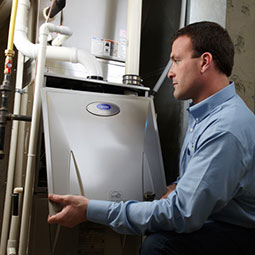Insider Hacks To Lowering Energy Costs This Winter
Posted on December 18, 2018 at 10:30 AM

To stay on top of new HVAC equipment and building technology on both the residential and commercial side, our factory-trained technicians regularly attend professional development sessions, and to stay current on what’s happening in the field, we have regular meetings in the office.
One of the major insights to come out of the accumulative wisdom of our in-house meetings is that even as HVAC equipment and building materials evolve, the same fundamental problems undermine the efficacy of even the most sophisticated climate-control systems. Whether your house was built when Pierce Refrigeration was established in 1936 or 2018, follow this 3-step process for taking control of your indoor climate this winter and, as a result, how much you pay to regulate it.
1. Start by inspecting and assessing your equipment.

This process should really begin in late summer to allow for enough time to schedule a preventative maintenance appointment. Follow this link to find a lot more information about tuning up your furnace. If you’re a first-time homeowner or have never had to worry about your HVAC system before, you want to begin by finding your equipment. The furnace is typically in the basement or utility room and heat pumps are usually somewhere along the exterior of the home.
Brush away all the cobwebs and dust on your furnace and pull away any dead vines and growth entangled in your heat pump. Look for the Energy Star label and the seasonal energy-efficiency ratio (SEER), which is typically on a yellow label. The Energy Star label, which is given to companies that participate in a voluntary federal program, is enough to distinguish equipment as energy efficient. However, the SEER number works on a sliding scale, and a low rating means the equipment uses more energy than units with higher ratings. This advice is particularly important for new homeowners with older homes, as well as homeowners who haven’t updated their HVAC system in more than a decade. The typical gas- and oil-fired furnace will last for 15 to 20 years with regular maintenance, according to the experts at This Old House. If yours is getting up in age, you may want to consider budgeting and researching for an upgrade—newer equipment can save you an additional 20% on heating costs.
2. Tighten up the drafty areas of your home.

Those homeowners who have spent a few years in their current home may know the drafty spots and the nuances of how different rooms feel during hot and cold weather. New homeowners may not know the quirks of their house, yet. Either way, a formal energy audit by your local utility company is typically free and always a brilliant money-saving move. Knowledgeable, expert assessors uncover the areas of your home that could use an upgrade in energy efficiency, and they educate you on the current incentives, rebates, and financing programs available to make those money-saving upgrades possible.
In the meantime, do your own detective work. Explore your attic, knee walls, cantilevers, and eaves. These are all hard-to-reach areas where framing comes together, and many times these areas are under insulated. The same is true for the headers and sills of windows, according to This Old House general contractor Tom Silva. The areas above and below the window often need additional insulation and sealing. Adding insulation to a home is an easy process the energy expert who does your audit can help you arrange—typically with a participating insulation company at a very competitive price. Better yet, replace those old windows all together and save yourself money in long-term energy costs and the hassle of sealing them all yourself.
You can cut up to 25% off your energy costs just by tightening up those drafty areas, according to the U.S. Department of Energy. This savings is year-round because your air conditioner won’t have to work as hard, either.
3. Make conserving energy a no-brainer.

If you’re feeling overwhelmed at this point . . . relax. Unless you move a lot, once you tighten up your house, you’re pretty much set for a while as long as you keep up with regular maintenance. So, to make saving money on energy costs easy, let’s get some clarity.
There’s no need to wear heavy coats and see your breath indoors to optimize heating costs. If a dwelling is properly insulated and tight, the optimal indoor temperature for your energy-efficient HVAC equipment to sustain is a maximum of 68 degrees Fahrenheit during the day, according to the California Energy Commission’s Consumer Energy Center. Then, you can lower your heating costs by 5% for every degree you drop your thermostat down to 60 degrees.
Does your bedroom have south-facing windows? Try keeping the curtains open during the day to let in the warming sun, and close them when the sun goes down to retain the heat. Another energy-efficient solution to controlling the climate of individual rooms is to install a ductless mini-split. The individual thermostat on the air handler can keep your toasty at night while you comfortably rest knowing you aren’t paying to heat the entire house.
The key to minimizing waste is to use only what you need. The U.S. Department of Energy says you can save as much as 10% annually by turning down the thermostat 7 to 10 degrees for 8 hours a day, which is possible with simple timers on most of today’s thermostats. Cutting-edge smart thermostats learn your living habits and automatically adjusts the temperature to the times you’re home, awake, and sleeping. The Nest thermostat reports up to 12% savings on heating costs and up to 15% on cooling by using this technology.
If this article is useful to you, please Like it below. If you know someone who can benefit from it, please Share it.
If your question isn’t answered here, contact the Pierce Refrigeration team and one of our experts will guide you in finding your solution.
Need 24-7 emergency service? Looking for advice on improving your everyday air quality and comfort at home and at work?
Contact the friendly staff at Pierce Refrigeration at
800-696-1088
info@piercerefrig.com
The Pierce team focuses entirely on heating, air conditioning and indoor air quality. We understand these technologies, work with them every day, and our people are factory-trained and fully certified.
Visit our websiteGet the best summertime performance from your central air and mini-split systems.
Read more.
Do I really need an AC tuned-up?
Read more.
Do you really need a furnace tune-up?
Read more.
Telephone
Toll-free: 800-696-1088508-586-1088
617-698-1272
After Hours and Weekend Emergency
781-961-6463
Email
info@piercerefrig.com
Mailing Address
439 East Center Street
P. O. Box 40
West Bridgewater, MA 02379
Website
www.piercerefrig.com